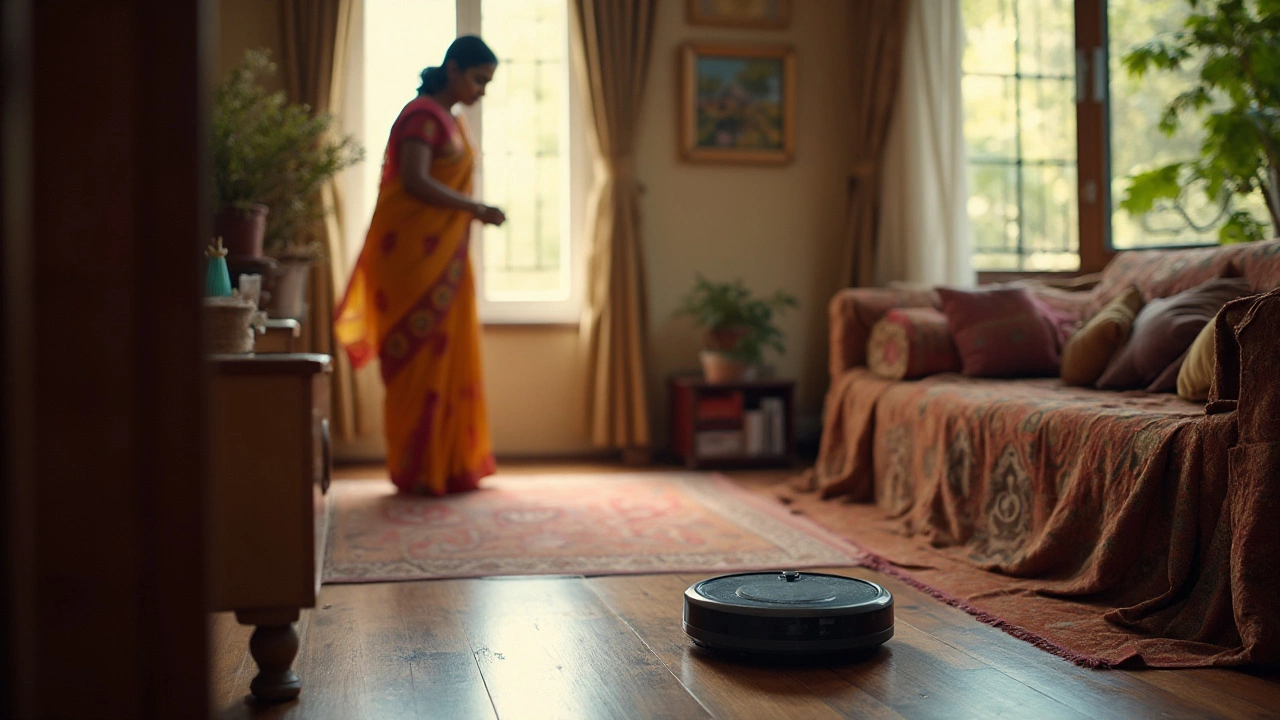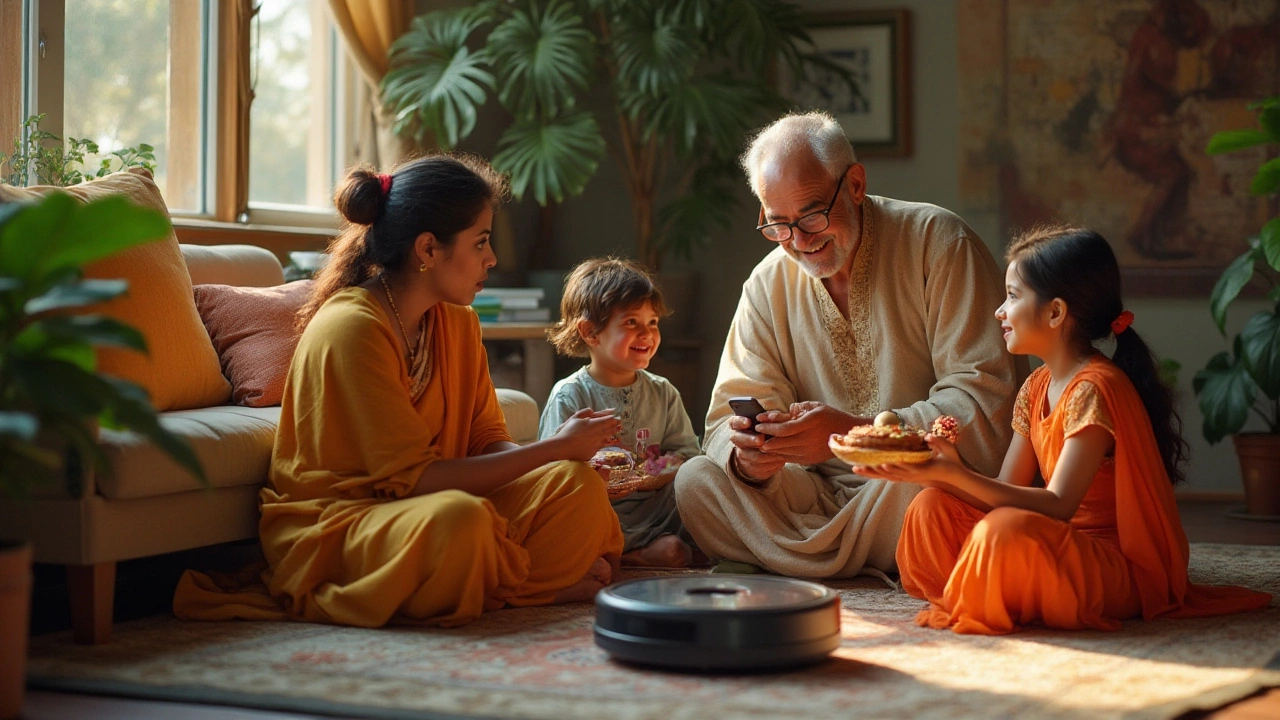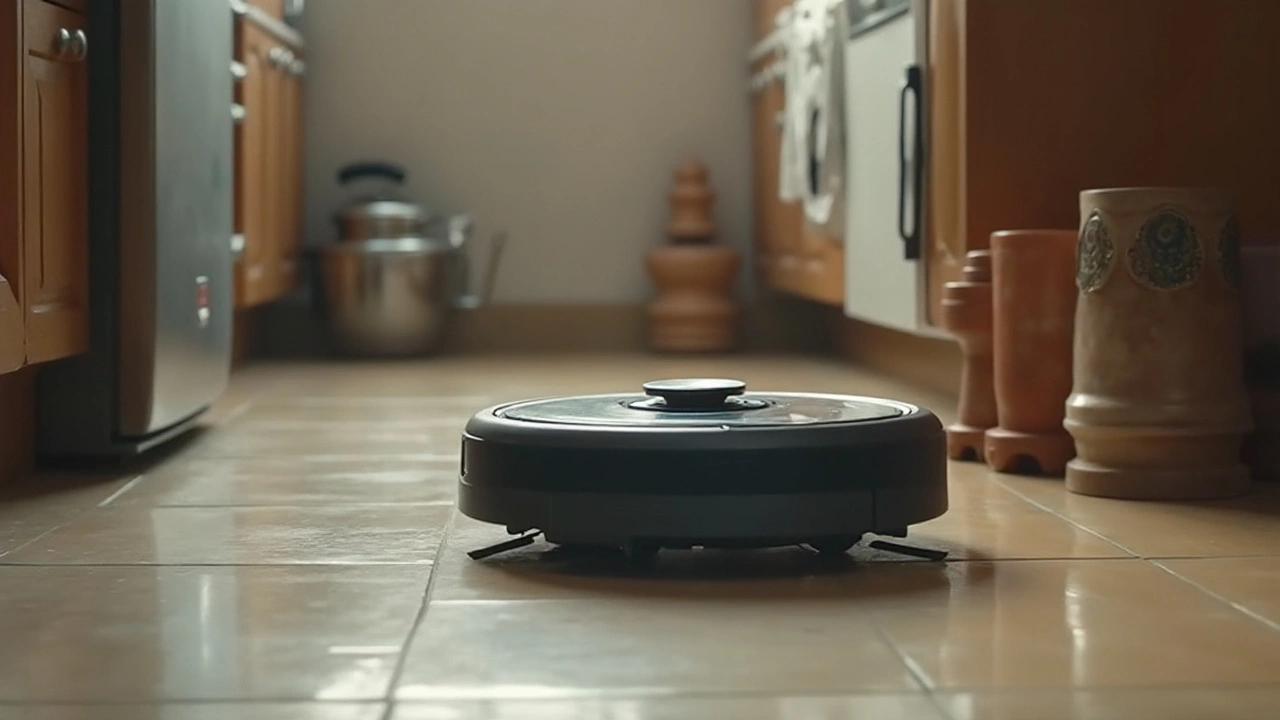
In the evolving world of household robotics, the Roomba has established itself as a staple in maintaining clean floors with minimal effort. But what happens when you need your Roomba to clean another room? Is it as simple as just picking it up and moving it?
For Roomba owners, understanding the ins and outs of its navigation technology and cleaning patterns is crucial, especially when relocating it to a new area. Let's dive into how you can ensure your Roomba performs optimally, even when navigating an entirely new terrain.
- Understanding Roomba's Mapping Technology
- Impact on Cleaning Efficiency
- Best Practices for Moving Your Roomba
- Common Mistakes to Avoid
- Tips for Optimizing Performance
- FAQs about Roomba Mobility
Understanding Roomba's Mapping Technology
Roomba's journey to vacuum mastery doesn't just happen by chance. At the heart of Roomba's ability to clean efficiently lies its state-of-the-art mapping technology. Known as iAdapt, this technological system serves as the brain behind the machine, guiding its movements and cleaning paths. The Roomba creates a map of your space using a combination of sensors and cameras. These components work together to detect obstacles, stairs, and dirty spots. The smart use of cameras allows Roomba to recognize the layout and furniture placements, making sure it can navigate with a distinct level of precision. The mapping system, while not visible to us, is constantly updating and recalibrating as the vacuum cleaner roams around your home, ensuring that no speck of dust is left unnoticed.
The remarkable thing about this technology is its ability to learn. Over time, as your Roomba continues its routine, it becomes more familiar with your house, progressively enhancing its route efficiency. This means that relocating it to a new environment might temporarily throw off its groove, but it quickly adapts. Roombas equipped with the latest models even feature the Imprint Smart Mapping, which allows the user to label different rooms and clean them as per their designation. This tagging can enhance cleaning efficiency, especially if you're running on a tight schedule. For instance, if you want to spruce up just the kitchen before guests arrive, Roomba allows you to send it specifically there without fuss.
According to a study conducted by Consumer Reports, automated vacuums with advanced mapping technology have a significant edge over those without. They tend to cover areas more thoroughly and with more accuracy. In Roomba’s case, deploying the iAdapt technology means a smoother cleaning experience for users, minimizing the traditional bumps and starts associated with earlier robot models. Some folks might wonder whether all this technology is really necessary, but the efficacy it provides when ensuring every inch of your floor is covered cannot be overstated. A well-mapped floor plan means fewer passes over the same spot and a more even distribution of cleaning energy.
The New York Times highlighted that "Roomba's intelligent mapping feature is as revolutionary for the home as GPS technology is for road travel." This is no small thing, considering it wasn't that long ago when vacuums depended solely on touch and bump technology.
The impact of this mapping technology also extends beyond just cleaning. It poses an interesting consideration for moving your Roomba from one room to another. Sure, you can easily pick it up and plop it in a new area. The challenge lies in how quickly and effectively it can adapt to its new surroundings. Without a pre-existing mental map, the device might take a little longer to cover the room effectively on the first few runs. But fret not, given time, Roomba’s adaptability means it swiftly gets back to peak performance level.
Incorporating such an intelligent system means homeowners can have an advanced cleaning experience that caters specifically to their home’s unique situational challenges. The benefits of Roomba's mapping technology extend beyond just the convenience of not having to supervise your vacuum cleaner. The ability to save maps and utilize them when needed means less energy consumption and higher cleaning scores, making your robotic helper an environmentally sound choice as well as a practical one.
Impact on Cleaning Efficiency
Shifting your Roomba from one room to another can have a significant effect on its cleaning efficiency. Understanding the impact on cleaning performance helps make informed decisions about how and when to move your robotic helper. At its core, the Roomba relies on sophisticated algorithms and sensors to learn and map out a home’s layout. It uses this data to navigate seamlessly, ensuring every bit of dirt and dust finds its way into the bin. So, when you pick up this trusty device and drop it into a new environment, there's a momentary pause in its routine as it attempts to recalibrate.
On entering uncharted territory, your Roomba momentarily loses its bearings and must begin the mapping process anew. This exploratory stage varies depending on the model. Some advanced models now feature

Best Practices for Moving Your Roomba
When considering moving your Roomba to a different room, there are several key practices to ensure your little robotic helper continues to function optimally. First and foremost, it's essential to understand how your Roomba’s navigation system works. Most Roomba models use a combination of cameras and sensors to map out their environment. This means that when you change rooms, the robot's memory may need to start fresh, especially if the new room is not part of its regular cleaning cycle. Clearing unnecessary obstacles beforehand can aid in this transition. Doing so not only prevents your Roomba from getting confused but also helps it save energy by avoiding unnecessary detours.
One practical tip is to manually transport not just the Roomba but also its charging base to the new room. Allowing your Roomba to begin and end its cycle from the base in the new location can help it orient itself better. This simple step permits the Roomba to establish a more accurate layout of its new surroundings, thus improving its cleaning efficiency. To optimize cleaning paths, it's essential to perform regular software updates to ensure that your Roomba incorporates the latest navigation technology advances.
Another significant aspect that often goes overlooked is the maintenance of the Roomba’s sensors. Dust build-up on these sensors can hinder the robot’s ability to detect changes in its environment. Therefore, routinely cleaning these sensitive areas can ensure better accuracy when mapping out new rooms. According to iRobot, the manufacturer, keeping your device clean can extend its lifespan and improve its efficiency.
“Keeping your robot clean allows for optimal performance and a longer life span of your device,” states the official iRobot blog.Additionally, consider the flooring texture of the new room. Thick carpets or uneven surfaces can cause the Roomba to exert additional effort, potentially draining the battery faster.
A practical piece of advice involves timing. If you intend to relocate your Roomba regularly, it’s beneficial to create a cleaning schedule that allows it at least one or two days to adapt to each new environment. This adaptation period helps the device learn and memorize the room’s layout. You should avoid frequently swapping back and forth between rooms in a short period, as this can confuse the device and reduce cleaning efficiency. Instead, allow some stability in your plan to let the robot do what it does best—clean effectively.
Lastly, engaging in some trial and error is never a bad idea. Every home is unique, so while your neighbor might have found a great setup and routine for their Roomba, yours might require a different approach. Be patient as you discover what works best in your situation. By focusing on these practices, you not only improve your Roomba's cleaning efficiency but also its longevity, offering better returns on your investment in smart home technology. By following these steps, you ensure that your trusted robot vacuum cleaner functions seamlessly in every corner of your home.
Common Mistakes to Avoid
Many people believe that owning a Roomba is a set-and-forget scenario, where the robot vacuums every nook and cranny regardless of how you manage it. However, there are several pitfalls when picking up and moving your Roomba that can directly affect its efficiency and lifespan. One of the most frequent errors involves disrupting its mapping process. Each time you relocate your Roomba to a different room without proper setup, you disturb its learned map, if applicable, leading to disorientation and, ultimately, inefficient cleaning. This is particularly true for models that build a detailed map of your home over time. Without clear boundaries and starting points, your Roomba might spend excessive time re-mapping the area instead of cleaning efficiently.
Another mistake is neglecting to ensure the new room is prepared for cleaning. People often forget that robot vacuum cleaners may face obstacles that weren't present in previous rooms, like loose cords, small objects, or low-lying furniture. These can become snags for the Roomba, tangling in its brushes or preventing its movement. By not prepping the room beforehand, time and cleaning power are lost as the Roomba struggles with the unexpected. Taking a few moments to tidy up can significantly enhance the cleaning process. Additionally, consistency in the place you deploy the Roomba is critical. Frequent relocations can confuse even the most advanced models, leading to inefficient cleaning patterns.
Battery management also plays a pivotal role in the effective functioning of your Roomba. Many users make the mistake of moving their Roomba without ensuring its battery is adequately charged. Relocating it back to its docking station or manually charging it between room changes can prevent this oversight. If a Roomba's juice runs out midway cleaned, it has to start all over, which can be frustrating and time-consuming. There’s a statistic showing a significant increase in Roomba models regaining their docking station more than 80% when left undisturbed in one environment compared to many. Lastly, keep in mind that while it might seem intuitive to move your Roomba for quick cleanings here and there, sticking to a regular cleaning schedule is vital. Consistency helps it learn the different spaces in your home more efficiently, reducing the chances of missed areas or repeated paths.
The Germany-based technical magazine Robotic Life highlighted, "Inconsistent placement and relocation of robotic vacuum cleaners can lead to disruptions in cleaning patterns, as they rely heavily on environmental cues and established paths to function optimally."

Tips for Optimizing Performance
When considering how to get the most out of your Roomba, one must delve beyond just the simple act of pushing a button. Enhancing your Roomba's efficiency involves a more strategic approach to ensure that it navigates all spaces effectively and maximizes its cleaning power. The first vital step is maintaining its cleanliness; a clean robot vacuum certainly performs at its best. Frequently emptying the dustbin and brushing off any debris or hair wrapped around the roller brushes will help the device tackle floors without hindrance. Cluttered rollers can lead to reduced suction and battery exhaustion since the device works harder to do the same job. According to a report from a leading consumer advocate organization, cleaning the bin and brushes after every three or four uses can improve performance by up to 20%.
Battery performance is another key factor in optimizing your Roomba's overall functioning. To ensure your robot vacuum cleaner remains operational, regularly charge it and if you notice performance issues, recalibrate the battery. This involves running a full cleaning cycle until the battery is exhausted, then allowing it to charge uninterrupted. Such practices can extend the battery life and maintain peak cleaning sessions. Studies indicate that improper charging habits can decrease battery efficiency by as much as 30%. Keeping it on home base when not in use is an ideal practice, as this ensures it’s ready for service when needed.
Room mapping is crucial for a Roomba to clean effectively, especially when it is frequently moved from one room to another. Allow it ample time during its initial runs to learn the layout. This process helps in creating an efficient cleaning path, reducing redundancy and time taken to clean areas already covered. Some models come equipped with sophisticated smart mapping features, which are visually detailed representations of your home space. If your Roomba has this feature, utilize the mobile app to set no-go zones and room-specific cleaning. Make sure to update the app regularly, employing the latest enhancements that cater to your specific cleaning needs.
Cleansing expert Jane Doe mentioned, “For an enhanced cleaning experience, regularly update your vacuum's firmware through its respective app. These updates frequently tackle bugs and introduce improvements that make your Roomba more adept at cleaning.”
Another tip to bear in mind is setting scheduled runs when nobody is around, as this not only simplifies the cleaning process without foot traffic but often gives Roomba the freedom to do a more thorough job. It allows the device to cover high-traffic zones more meticulously. Additionally, for those with pets, a strategy worth considering is scheduling Roomba runs after grooming sessions to minimize hair accumulation on the brushes.
Most importantly, remember to periodically check the wheels and sensors. Cleaning around these components will help maintain smooth maneuverability and accurate direction changes when transitioning between different surfaces. These maintenance practices combined will maximize the cleaning efficiency, helping your beloved Roomba to keep your floors sparkling with minimal intervention from your side.
FAQs about Roomba Mobility
Roombas are brilliant little devices when it comes to keeping your floors tidy, and many people wonder about their flexibility when it comes to movement across different spaces. Let's delve into some of the most frequently asked questions about the mobility of your Roomba.
One common question is: can you relocate your Roomba from room to room, and how does it affect performance? Yes, you can move a Roomba to another room, but understanding how it affects its cleaning routine is crucial. Roombas utilize advanced sensors and mapping technology to learn the layout of your home. When you pick it up and place it in a different location, it might take a while for the device to re-orient itself in this new environment. This means the more you familiarize your Roomba with rooms, the efficiently it can clean them as it builds a virtual map of your home with every cleaning cycle. However, it should not discourage you if deep cleaning requires relocating the device, as this flexibility is part of what makes the robot vacuum cleaner so user-friendly.
Another question people often ask is whether moving the Roomba will erase its memory. The good news is that while shifting your Roomba can disrupt its current cleaning session, it shouldn’t wipe its memory permanently. The newer models are equipped with more robust memory capabilities, retaining knowledge about the layouts and areas already mapped. However, it might momentarily lose track during a session if it starts in a completely different part of the house.
"The way Roomba navigates a room is akin to training for a marathon—it learns and adapts with every step," says a famous robotics expert.
Moreover, some users wonder if constant relocation affects the battery life or charging. As far as the battery is concerned, relocating a Roomba physically does not directly impact its power consumption. Efficiency and battery life could be affected if it consistently cleans larger, unfamiliar areas without docking for a recharge. Thus, keeping the charging station accessible wherever you relocate the device is critical. Modern Roombas typically return to their dock when they sense battery depletion, so ensure the dock is located in a space it easily reaches.
Many curious minds also ask how the Roomba handles multi-level homes. Roombas are designed to handle multiple floors, but switching between them isn’t as seamless as transitioning between rooms on a single level. You will have to move the Roomba physically between floors and its charging dock will need relocating, too. To maintain efficiency, the device will need time to learn each floor’s layout separately. Some users find a solution in owning a dock for each level, allowing the Roomba to charge quickly without needing to track its way blindly to one central station.
Lastly, the query about maintenance after relocating the Roomba often arises. It’s important to check for trapped debris in brushes or sensors after conducting several relocations, as foreign objects might jar the machine’s sensors during cleaning routes. By performing regular maintenance checks, you ensure that the Roomba continues to operate efficiently and maintain high cleaning efficiency.